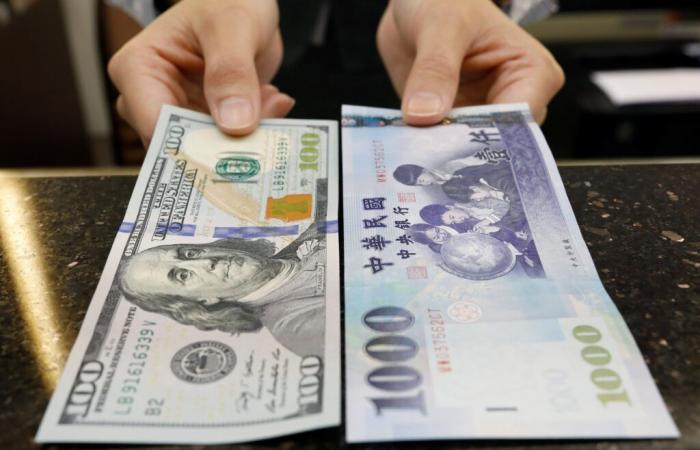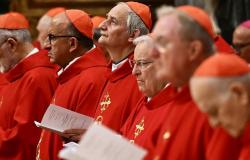The unprecedented increase in the Taiwanese motto in the past two days is the last stage of a leak from the US dollar and the sign of market concern, while the trade war waged by US President Donald Trump shakes confidence and disrupts commercial relations.
Taiwan occupies a place that is both precious and vulnerable in the world economy, as the first manufacturer of high-end computer flea and supplier from the United States and China.
Its currency, generally controlled by a central bank responsible for ensuring its stability, jumped 8 % in two days, traders complaining of the absence of buyers for US dollars that insurers, exporters and investors suddenly wanted to sell.
The precise trigger for this sudden increase was not clear.
However, this development coincided with the end of commercial negotiations between the United States and Taiwan in Washington, which fueled speculation on an agreement aimed at weakening the greenback in exchange for commercial concessions.
Such an agreement has been denied several times by the Central Bank, but it is not completely excluded by the market, which sees in the rise of the Taiwanese dollar a tacit approval and a measure likely to be welcomed by the United States.
The magnitude of the recovery suggests that an important reversal is underway and highlights one of the many economies where years of significant commercial surpluses have led exporters and insurers to accumulate large long positions on the dollar, which are today questioned and under pressure.
“The Taiwanese dollar is appreciated at a faster rate that I have never seen,” said a senior official in the Taiwanese financial sector, under the cover of anonymity because it was not allowed to express themselves in the media.
“Speculative capital flock to Taiwan, and the central bank allows it. Many say that it is due to pressure from the United States. I would say that this is certainly the case. »»
The Taiwanese central bank said on Monday that the United States had not requested a strengthening of the Taiwanese dollar and that the currency had been volatile in recent times due to the influx of foreign funds and anticipations of companies in strengthening the Taiwanese dollar.
The Taiwanese president Lai Ching-Te also intervened on Monday to ask the population not to disseminate false information concerning negotiations with the United States on the exchange rate.
The Taiwan commercial negotiation office said on Monday that last week’s discussions did not involve the central bank and had not addressed the exchange rate issue. The currency reached its highest level on Monday in more than two years, ending at 30,145 for a dollar.
How did it go?
The Taiwanese dollar has been up since early April, when Mr. Trump announced his heaviest customs duties and imposed an import tax of 32 % on Taiwan, since suspended.
This trend seems to have been triggered by the appeasement of tensions between the United States and China, but it was then self-propelled, the unique characteristics of the Taiwanese financial markets that have led to desperate purchases.
Exporters have seen the value of their revenue in US dollars drop and insurers have seen the value of their large offshore assets decrease in Taiwanese dollars. The exporters then rushed to convert their assets and the insurers hastened to cover their exposure to the exchange risk.
“The interest in the sale (of the US dollar) comes from the interior of the country,” said Tareck Horchani, head of first -rate brokerage operations at Maybank Securities in Singapore.
This then pushed foreigners with leverages on the Taiwanese dollar, cheap to borrow, to withdraw, and forced purchases of Taiwanese dollars accelerated the movement.
It is true that Friday and Monday, the motto stabilized after the morning increases and that the central bank reaffirmed on Monday that it would do everything possible to maintain stability.
However, the speed and magnitude of the increase – a statistical event corresponding to a standard deviation of 19 – indicate that forces in the longer term are at work.
“This underlines how much the accumulation of low-noted financial imbalances can lead to brutal corrections when the underlying political context undergoes a major upheaval,” said Aninda Mitra, responsible for the macroeconomic strategy for Asia at the BNY Investment Institute.
And those who speculate on a broader upheaval while the Trump administration seeks to redefine its trade relations see it as a warning sign of a new phase of dollar weakness in Asia.
“Although the question of whether (the Trump administration) can repatriate production in the United States remains open and we are unable to know it with certainty, the weakness of the dollar is undoubtedly an integral part of its strategy,” said Sunil Kalra, portfolio manager at LC Beacon Global Fund.
“The conditions are therefore met, and if so far, the weakness of the dollar has mainly manifested in precious metals and G10 countries, the moment has finally come to extend to emerging, in particular Asian markets, which have been late? »(Report of Ankur Banerjee, Tom Westbrook, Rae Wee and Vidya Ranganathan in Singapore, Ben Blanchard, Faith Hung, Liang-Sa Loh and Jeanny Kao in Taipei. Writing: Tom Westbrook. Edition: Kate Mayberry)








